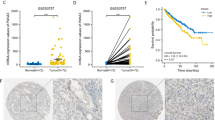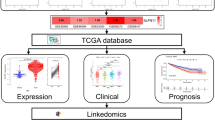Abstract
S100A6 (calcyclin), functions in cell cycle progression and differentiation, has been reported to promote the tumorigenesis and malignancy of many types of cancers. Clear cell renal cell carcinoma (ccRCC) is the most common subtype of RCC, lacking both promising prognostic markers and effective therapeutic targets. In our previous study, we have found the elevated S100A6 in the ccRCC tumor tissues, and the differentially expressed genes determined by microarray analysis were found to be strongly related to tumor metastasis after S100A6 knockdown and overexpression in the ccRCC cell line 786-O. The mRNA expression of S100A6 detected by RT-PCR in 6 cell lines and 174 tumor tissues, including 58 metastatic ccRCC and 116 clinicopathological features paired non-metastatic ccRCC (1:2), indicated S100A6 was elevated in the metastatic cells and tumor tissues. The protein expression was consistent with mRNA expression. The biological function of S100A6 in promoting metastasis was determined through overexpression and knockdown of S100A6 in the ccRCC cell lines 786-O, caki-1, and ACHN. In the scratch wound migration assay as well as migration and invasion assays, S100A6 knockdown significantly suppressed the migratory and invasive abilities of tumor cells, whereas overexpression enhanced the malignancy. Further research with the follow-up data of 129 ccRCC patients were analyzed by the Cox regression and survival analysis. The expression of S100A6 was up-regulated in metastatic ccRCC cells. In the metastatic tumor tissues, the expression of S100A6 was also higher than in the non-metastatic tissues. High S100A6 expression might be crucial to promote metastasis in ccRCC by enhancing the ability of tumor cells migration and invasion. In addition, the quantitative mRNA expression of S100A6 in the tumor tissues was an independent risk factor and might be used as a prognostic marker for the metastatic risk of the localized T1–T2 stage ccRCC.






Similar content being viewed by others
References
Jemal, A., Bray, F., Center, M. M., Ferlay, J., Ward, E., & Forman, D. (2011). Global cancer statistics. CA: Cancer Journal for Clinicians, 61, 69–90.
Gupta, K., Miller, J. D., Li, J. Z., Russell, M. W., & Charbonneau, C. (2008). Epidemiologic and socioeconomic burden of metastatic renal cell carcinoma (mRCC): A literature review. Cancer Treatment Reviews, 34, 193–205.
Motzer, R. J., Bacik, J., Schwartz, L. H., Reuter, V., Russo, P., et al. (2004). Prognostic factors for survival in previously treated patients with metastatic renal cell carcinoma. Journal of Clinical Oncology, 22, 454–463.
Sastry, M., Ketchem, R. R., Crescenzi, O., Weber, C., Lubienski, M. J., et al. (1998). The three-dimensional structure of Ca(2+)-bound calcyclin: Implications for Ca(2+)-signal transduction by S100 proteins. Structure, 6, 223–231.
Calabretta, B., Battini, R., Kaczmarek, L., de Riel, J. K., & Baserga, R. (1986). Molecular cloning of the cDNA for a growth factor-inducible gene with strong homology to S-100, a calcium-binding protein. Journal of Biological Chemistry, 261, 12628–12632.
Courtois-Coutry, N., Le, M. C., Boulkroun, S., Fay, M., Cluzeaud, F., et al. (2002). Calcyclin is an early vasopressin-induced gene in the renal collecting duct. Role in the long term regulation of ion transport. Journal of Biological Chemistry, 277, 25728–25734.
Breen, E. C., & Tang, K. (2003). Calcyclin (S100A6) regulates pulmonary fibroblast proliferation, morphology, and cytoskeletal organization in vitro. Journal of Cellular Biochemistry, 88, 848–854.
Weterman, M. A., Stoopen, G. M., van Muijen, G. N., Kuznicki, J., Ruiter, D. J., & Bloemers, H. P. (1992). Expression of calcyclin in human melanoma cell lines correlates with metastatic behavior in nude mice. Cancer Research, 52, 1291–1296.
Komatsu, K., Murata, K., Kameyama, M., Ayaki, M., Mukai, M., et al. (2002). Expression of S100A6 and S100A4 in matched samples of human colorectal mucosa, primary colorectal adenocarcinomas and liver metastases. Oncology (Williston Park), 63, 192–200.
Komatsu, K., Andoh, A., Ishiguro, S., Suzuki, N., Hunai, H., et al. (2000). Increased expression of S100A6 (calcyclin), a calcium-binding protein of the S100 family, in human colorectal adenocarcinomas. Clinical Cancer Research, 6, 172–177.
Komatsu, K., Kobune-Fujiwara, Y., Andoh, A., Ishiguro, S., Hunai, H., et al. (2000). Increased expression of S100A6 at the invading fronts of the primary lesion and liver metastasis in patients with colorectal adenocarcinoma. British Journal of Cancer, 83, 769–774.
Yang, Y. Q., Zhang, L. J., Dong, H., Jiang, C. L., Zhu, Z. G., et al. (2007). Upregulated expression of S100A6 in human gastric cancer. Journal of Digestive Diseases, 8, 186–193.
Vimalachandran, D., Greenhalf, W., Thompson, C., Luttges, J., Prime, W., et al. (2005). High nuclear S100A6 (calcyclin) is significantly associated with poor survival in pancreatic cancer patients. Cancer Research, 65, 3218–3225.
Shekouh, A. R., Thompson, C. C., Prime, W., Campbell, F., Hamlett, J., et al. (2003). Application of laser capture microdissection combined with two-dimensional electrophoresis for the discovery of differentially regulated proteins in pancreatic ductal adenocarcinoma. Proteomics, 3, 1988–2001.
Camby, I., Nagy, N., Lopes, M. B., Schafer, B. W., Maurage, C. A., et al. (1999). Supratentorial pilocytic astrocytomas, astrocytomas, anaplastic astrocytomas and glioblastomas are characterized by a differential expression of S100 proteins. Brain Pathology (Zurich, Switzerland), 9, 1–19.
Brown, L. M., Helmke, S. M., Hunsucker, S. W., Netea-Maier, R. T., Chiang, S. A., et al. (2006). Quantitative and qualitative differences in protein expression between papillary thyroid carcinoma and normal thyroid tissue. Molecular Carcinogenesis, 45, 613–626.
Pelc, P., Vanmuylder, N., Lefranc, F., Heizmann, C. W., Hassid, S., et al. (2003). Differential expression of S100 calcium-binding proteins in epidermoid cysts, branchial cysts, craniopharyngiomas and cholesteatomas. Histopathology, 42, 387–394.
Luo, X., Sharff, K. A., Chen, J., He, T. C., & Luu, H. H. (2008). S100A6 expression and function in human osteosarcoma. Clinical Orthopaedics and Related Research, 466, 2060–2070.
Ishii, A., Suzuki, M., Satomi, K., Kobayashi, H., Sakashita, S., et al. (2009). Increased cytoplasmic S100A6 expression is associated with pulmonary adenocarcinoma progression. Pathology International, 59, 623–630.
Ohuchida, K., Mizumoto, K., Ishikawa, N., Fujii, K., Konomi, H., et al. (2005). The role of S100A6 in pancreatic cancer development and its clinical implication as a diagnostic marker and therapeutic target. Clinical Cancer Research, 11, 7785–7793.
Wang, X. H., Zhang, L. H., Zhong, X. Y., Xing, X. F., Liu, Y. Q., et al. (2010). S100A6 overexpression is associated with poor prognosis and is epigenetically up-regulated in gastric cancer. American Journal of Pathology, 177, 586–597.
Warde-Farley, D., Donaldson, S. L., Comes, O., Zuberi, K., Badrawi, R., et al. (2010). The GeneMANIA prediction server: Biological network integration for gene prioritization and predicting gene function. Nucleic Acids Research, 38, W214–W220.
Mostafavi, S., Ray, D., Warde-Farley, D., Grouios, C., & Morris, Q. (2008). GeneMANIA: A real-time multiple association network integration algorithm for predicting gene function. Genome Biology, 9(Suppl 1), S4.
Jung, M., Ramankulov, A., Roigas, J., Johannsen, M., Ringsdorf, M., et al. (2007). In search of suitable reference genes for gene expression studies of human renal cell carcinoma by real-time PCR. BMC Molecular Biology, 8, 47.
Livak, K. J., & Schmittgen, T. D. (2001). Analysis of relative gene expression data using real-time quantitative PCR and the 2(−Delta Delta C(T)) method. Methods (San Diego, California), 25, 402–408.
Novara, G., Ficarra, V., Antonelli, A., Artibani, W., Bertini, R., et al. (2010). Validation of the 2009 TNM version in a large multi-institutional cohort of patients treated for renal cell carcinoma: Are further improvements needed. European Urology, 58, 588–595.
Pegoraro, S., Ros, G., Piazza, S., Sommaggio, R., Ciani, Y., et al. (2013). HMGA1 promotes metastatic processes in basal-like breast cancer regulating EMT and stemness. Oncotarget, 4, 1293–1308.
Liau, S. S., Jazag, A., & Whang, E. E. (2006). HMGA1 is a determinant of cellular invasiveness and in vivo metastatic potential in pancreatic adenocarcinoma. Cancer Research, 66, 11613–11622.
Kumar, M. S., Armenteros-Monterroso, E., East, P., Chakravorty, P., Matthews, N., et al. (2013). HMGA2 functions as a competing endogenous RNA to promote lung cancer progression. Nature, 9, 212–217.
Sun, M., Gomes, S., Chen, P., Frankenberger, C. A., Sankarasharma, D., et al. (2013). RKIP and HMGA2 regulate breast tumor survival and metastasis through lysyl oxidase and syndecan-2. Oncogene, 3, 328–330.
Liu, Z., Hartman, Y. E., Warram, J. M., Knowles, J. A., Sweeny, L., et al. (2011). Fibroblast growth factor receptor mediates fibroblast-dependent growth in EMMPRIN-depleted head and neck cancer tumor cells. Molecular Cancer Research, 9, 1008–1017.
Escobar, G. M. L., Jia, J., Zhang, X., Jastrebova, N., Spillmann, D., et al. (2007). Transgenic or tumor-induced expression of heparanase upregulates sulfation of heparan sulfate. Nature Chemical Biology, 3, 773–778.
Knelson, E. H., Gaviglio, A. L., Tewari, A. K., Armstrong, M. B., Mythreye, K., & Blobe, G. C. (2013). Type III TGF-beta receptor promotes FGF2-mediated neuronal differentiation in neuroblastoma. Journal of Clinical Investagations, 11, 4786–4798.
Missiaglia, E., Dalai, I., Barbi, S., Beghelli, S., Falconi, M., et al. (2010). Pancreatic endocrine tumors: Expression profiling evidences a role for AKT-mTOR pathway. Journal of Clinical Oncology, 28, 245–255.
Xu, Z., Pei, L., Wang, L., Zhang, F., Hu, X., & Gui, Y. (2014). Snail1-dependent transcriptional repression of Cezanne2 in hepatocellular carcinoma. Oncogene, 33, 2836–2845.
Zheng, D., Decker, K. F., Zhou, T., Chen, J., Qi, Z., et al. (2013). Role of WNT7B-induced noncanonical pathway in advanced prostate cancer. Molecular Cancer Research, 11, 482–493.
Neilsen, P. M., Noll, J. E., Mattiske, S., Bracken, C. P., Gregory, P. A., et al. (2013). Mutant p53 drives invasion in breast tumors through up-regulation of miR-155. Oncogene, 32, 2992–3000.
Kang, M. H., Kim, J. S., Seo, J. E., Oh, S. C., & Yoo, Y. A. (2010). BMP2 accelerates the motility and invasiveness of gastric cancer cells via activation of the phosphatidylinositol 3-kinase (PI3K)/Akt pathway. Experimental Cell Research, 316, 24–37.
Kumar, M., Allison, D. F., Baranova, N. N., Wamsley, J. J., Katz, A. J., et al. (2013). NF-kappaB regulates mesenchymal transition for the induction of non-small cell lung cancer initiating cells. PLoS ONE, 8, e68597.
Ding, X., Park, S. I., McCauley, L. K., & Wang, C. Y. (2013). Signaling between transforming growth factor beta (TGF-beta) and transcription factor SNAI2 represses expression of microRNA miR-203 to promote epithelial-mesenchymal transition and tumor metastasis. Journal of Biological Chemistry, 288, 10241–10253.
Yang, H., Rouse, J., Lukes, L., Lancaster, M., Veenstra, T., et al. (2004). Caffeine suppresses metastasis in a transgenic mouse model: A prototype molecule for prophylaxis of metastasis. Clinical & Experimental Metastasis, 21, 719–735.
Johnson, J. L., Pillai, S., Pernazza, D., Sebti, S. M., Lawrence, N. J., & Chellappan, S. P. (2012). Regulation of matrix metalloproteinase genes by E2F transcription factors: Rb-Raf-1 interaction as a novel target for metastatic disease. Cancer Research, 72, 516–526.
Tang, W., Zhu, Y., Gao, J., Fu, J., Liu, C., et al. (2013). MicroRNA-29a promotes colorectal cancer metastasis by regulating matrix metalloproteinase 2 and E-cadherin via KLF4. British Journal of Cancer, 2, 450–458.
Li, H., Huang, F., Fan, L., Jiang, Y., Wang, X., et al. (2013). Phosphatidylethanolamine-binding protein 4 is associated with breast cancer metastasis through Src-mediated Akt tyrosine phosphorylation. Oncogene. doi:10.1038/onc.2013.408
Chen, L., Li, M., Li, Q., Wang, C. J., & Xie, S. Q. (2013). DKK1 promotes hepatocellular carcinoma cell migration and invasion through beta-catenin/MMP7 signaling pathway. Molecular Cancer, 12, 157.
Lavilla-Alonso, S., Bauer, M. M., Abo-Ramadan, U., Ristimaki, A., Halavaara, J., et al. (2012). Macrophage metalloelastase (MME) as adjuvant for intra-tumoral injection of oncolytic adenovirus and its influence on metastases development. Cancer Gene Therapy, 19, 126–134.
Acknowledgments
This work was funded by National Natural Science Foundation of China (Nos. 81100483 and 30972982); and National High Technology Research and Development Program of China (863 Program) (No. 2012AA021100). We are grateful to Dr. Xiao-Ping Zhang of Wuhan Union Hospital for providing the SN12-PM6 cell lines. The authors also gratefully acknowledge Professors Ailing Li (Academy of Military Medical Sciences) and Tong Sun (Harvard Medical School) for providing valuable scientific discussions.
Conflict of interest
All of the authors declare that they have no conflict of interests.
Author information
Authors and Affiliations
Corresponding author
Additional information
Xiangjun Lyu and Hongzhao Li have contributed equally to this study.
Rights and permissions
About this article
Cite this article
Lyu, X., Li, H., Ma, X. et al. High-Level S100A6 Promotes Metastasis and Predicts the Outcome of T1–T2 Stage in Clear Cell Renal Cell Carcinoma. Cell Biochem Biophys 71, 279–290 (2015). https://doi.org/10.1007/s12013-014-0196-x
Published:
Issue Date:
DOI: https://doi.org/10.1007/s12013-014-0196-x




